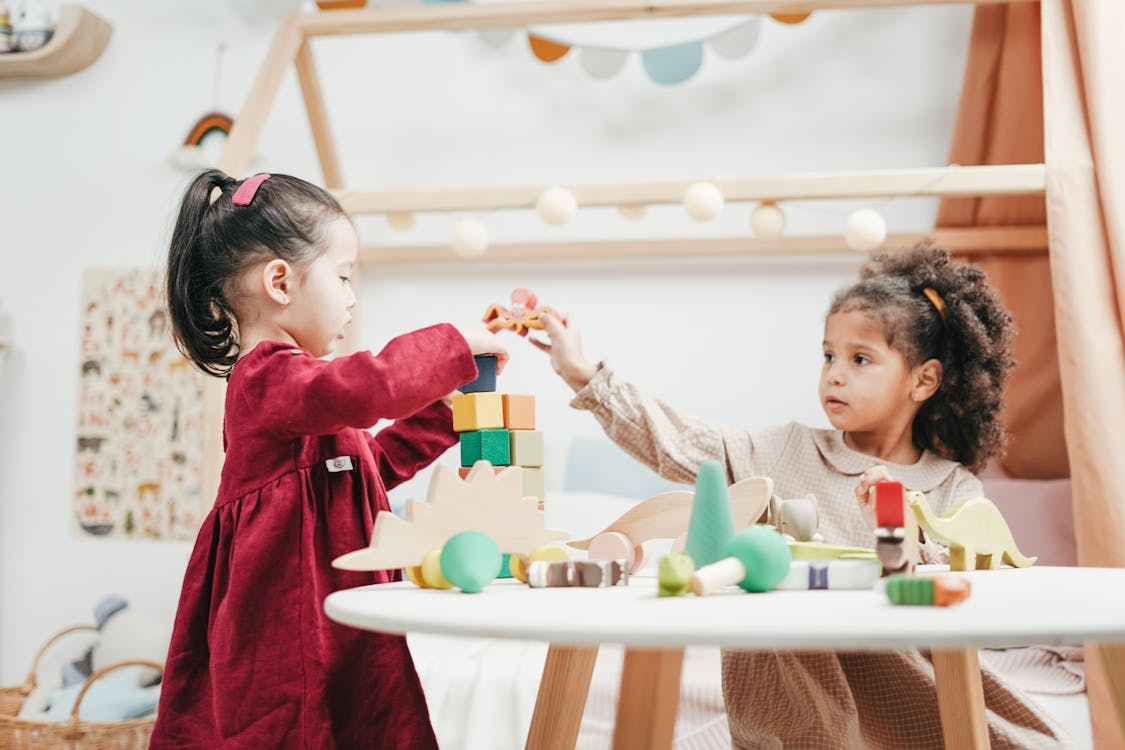Table of Contents
- What Exactly IS Critical Thinking? (And Why Does It Matter More Than Ever?)
- The Forgotten Classroom: How Play Naturally Cultivates Critical Thought
- Different Types of Play, Different Critical Thinking Boosts
- The Modern Challenge: Is Play Disappearing? And What Can We Do?
- Actionable Insights: Fostering Play for Sharper Minds (For Parents, Educators, and Everyone!)
- The Power of Play: A Foundation for Life
Unlocking Minds: The Surprising Power of Play in Developing Critical Thinking
Ever watched a group of children completely engrossed in building a magnificent, wobbly fort out of blankets and chairs? Or perhaps you’ve seen them passionately debating the rules of an imaginary game? It might look like simple fun and games, but what if I told you that within these playful moments, something incredibly profound is happening? These children aren’t just passing time; they’re actively forging the very foundations of critical thinking – a skill more vital today than ever before. In a world overflowing with information and complex challenges, the ability to think critically is paramount, and surprisingly, play is one of its most powerful, and often underestimated, architects.
This article delves into the fascinating connection between play and critical thinking. We’ll explore how different types of play nurture essential cognitive skills, why this connection is crucial in our modern lives, and what we can all do to ensure that play retains its rightful place as a cornerstone of development. Get ready to see playtime in a whole new, incredibly important light!
What Exactly IS Critical Thinking? (And Why Does It Matter More Than Ever?)
Before we dive into the playground, let’s clarify what we mean by critical thinking. It’s not about being negative or overly critical of others. Instead, it’s a higher-order thinking skill that involves:
- Analyzing information: Breaking down complex topics or problems into smaller, more manageable parts.
- Evaluating evidence: Assessing the credibility and relevance of information and arguments.
- Problem-solving: Identifying issues, exploring potential solutions, and implementing effective strategies.
- Decision-making: Making reasoned judgments and choices based on available information.
- Creative thinking: Generating novel ideas and approaching problems from different perspectives.
- Reflective thinking: Considering one’s own thinking processes and learning from experiences.
In our fast-paced, information-saturated world, these skills are no longer just ‘nice-to-haves’; they are essential. From navigating the complexities of the digital age and discerning fake news from fact, to innovating in the workplace and making informed life choices, critical thinking skills empower individuals to thrive. The future demands adaptable, resourceful, and analytical minds, and the seeds for these capabilities are often sown much earlier than we think – frequently, in the sandbox or during a game of make-believe.

The Forgotten Classroom: How Play Naturally Cultivates Critical Thought
Think of play as the child’s natural laboratory, a space where they are free to experiment, explore, and learn without the pressure of formal assessment. It’s within this dynamic environment that the building blocks of critical thinking are laid, often without a single worksheet or textbook in sight.
The Sandbox of Problem-Solving
Unstructured play, where children lead the activities themselves, is a goldmine for problem-solving. Imagine children trying to build a tower that reaches the ceiling with limited blocks. They’ll encounter problems: the tower is unstable, they run out of a certain type of block, or their initial design isn’t working. What happens next is pure critical thinking in action. They must:
- Identify the problem: “The tower keeps falling over.”
- Analyze the cause: “Maybe the base is too small, or we’re building it too fast.”
- Brainstorm solutions: “Let’s make the base wider!” “Let’s try different block shapes!”
- Test solutions: They try their new ideas.
- Evaluate results: “This is much sturdier!” or “That didn’t work, let’s try something else.”
This iterative process of identifying challenges, devising strategies, and testing outcomes is exactly what robust problem-solving through play looks like. Whether it’s figuring out how to share a coveted toy or designing a functional (in their eyes!) spaceship from cardboard boxes, children are constantly honing their analytical and problem-solving abilities.
Trial, Error, and Resilience: Learning from “Failures” in Play
Play provides an incredibly safe and low-stakes environment to experience what adults might call ‘failure’. When a block tower tumbles, or a pretend potion doesn’t ‘work’, the consequences are minimal. This freedom allows children to engage in trial and error learning without fear. Each ‘failed’ attempt isn’t a setback but a valuable piece of data, a lesson learned.
This process is crucial for developing resilience – the ability to bounce back from adversity. When children learn through play that it’s okay for things not to work out perfectly the first time, and that they have the capacity to try again and adapt their approach, they are building a resilient mindset. This very mindset is essential for tackling complex problems later in life, where setbacks are inevitable. Critical thinking isn’t just about finding the right answer; it’s also about the perseverance to keep searching when solutions aren’t immediately obvious. Play teaches this perseverance beautifully.
The Art of Negotiation and Collaboration
Watch any group of children engaged in social play, and you’ll witness a masterclass in negotiation, communication, and collaboration. Whether they’re deciding the rules of a game, assigning roles in a pretend scenario (“Okay, you be the dragon, and I’ll be the knight!”), or sharing resources, they are constantly practicing skills vital for critical thinking:
- Perspective-taking: Understanding how others see the situation.
- Communication: Clearly expressing their own ideas and listening to others.
- Compromise: Finding mutually agreeable solutions.
- Conflict resolution: Working through disagreements constructively.
These collaboration skills are fundamental to effective critical thinking, especially in team-based environments common in higher education and the professional world. Play allows children to practice these intricate social dances in a self-directed way, learning to navigate complex social dynamics and value diverse viewpoints – all of which enriches their ability to think critically about multifaceted issues.

Unleashing Creativity and Innovation
Creative play is where imagination takes flight, and it’s a powerful engine for critical thinking. When children invent new games, tell original stories, or use objects in unconventional ways (a stick becomes a magic wand, a box becomes a time machine), they are engaging in divergent thinking – the ability to generate multiple, novel ideas.
This is a cornerstone of innovative thinking. Critical thinking isn’t just about analyzing existing information; it’s also about synthesizing information in new ways to create something original. Play fosters this by encouraging children to think outside the box, to experiment with possibilities, and to not be constrained by conventional uses or ideas. This flexible, imaginative mindset is invaluable when facing novel problems that require fresh perspectives and inventive solutions.
Developing Executive Functions – The Brain’s CEO
Often working behind the scenes during play are crucial cognitive processes known as executive functions. These are the brain’s air traffic control system, helping us manage our thoughts, actions, and emotions. Key executive functions include:
- Working memory: Holding and manipulating information in mind (e.g., remembering the rules of a game).
- Inhibitory control: Resisting impulses and distractions (e.g., waiting for one’s turn).
- Cognitive flexibility: Shifting between different tasks or perspectives (e.g., adapting when the rules of a game change or a friend wants to play something new).
Play, especially games with rules or complex pretend scenarios, provides constant practice for these skills. For example, a child playing ‘Simon Says’ is exercising inhibitory control. Children collaboratively building a den are using working memory to keep the plan in mind and cognitive flexibility to adapt if materials run short. Strong executive functions are the bedrock upon which higher-level critical thinking is built. Without the ability to focus, remember, and adapt, complex analysis and problem-solving become significantly harder. Play helps to strengthen this vital cognitive infrastructure.
Different Types of Play, Different Critical Thinking Boosts
Not all play is the same, and various forms of play can emphasize different aspects of critical thinking development. Understanding these nuances can help us appreciate the broad impact of play.
Constructive Play (Building Blocks, LEGOs, Art)
This type of play involves manipulating materials to create something new. Think LEGOs, building blocks, sandcastles, drawing, or even assembling a model. Constructive play is fantastic for developing:
- Spatial reasoning: Understanding how objects fit together in space.
- Planning and sequencing: Thinking ahead about the steps needed to achieve a goal.
- Problem-solving: Figuring out how to make a structure stable or achieve a desired artistic effect.
- Mathematical concepts: Early understanding of size, shape, balance, and symmetry.
The very act of building requires children to hypothesize, test, and refine their ideas – core components of critical thought.
Imaginative/Pretend Play (Dress-up, Storytelling, Role-Playing)
Also known as dramatic play, pretend play is where children take on roles, create narratives, and explore different scenarios. A stick might become a sword, a doll might become a patient. This type of play is incredibly rich for fostering:
- Empathy and perspective-taking: Stepping into someone else’s shoes and imagining their thoughts and feelings.
- Abstract thought: Using objects to symbolize other things.
- Narrative skills: Developing the ability to create and follow a storyline, which aids in understanding cause and effect.
- Language development: Expanding vocabulary and practicing communication in different contexts.
These skills are crucial for understanding complex social situations and analyzing information from multiple viewpoints.

Games with Rules (Board Games, Card Games, Sports)
Whether it’s a classic board game, a simple card game, or organized sports, games with rules offer structured opportunities for critical thinking:
- Strategic thinking: Planning moves ahead and anticipating an opponent’s actions.
- Logical reasoning: Understanding cause and effect within the game’s framework (if I do X, then Y will happen).
- Following instructions and understanding systems: Learning and adhering to a set of predefined rules.
- Fairness and turn-taking: Developing social understanding and cooperation.
- Decision-making under pressure: Making choices that have clear consequences within the game.
These games explicitly teach children to think systematically and strategically, skills directly transferable to academic and real-world problem-solving.
Outdoor/Physical Play (Running, Climbing, Exploring Nature)
Don’t underestimate the cognitive benefits of running, jumping, climbing, and exploring the great outdoors! Outdoor play and physical activity contribute to critical thinking by:
- Risk assessment and management: Learning to judge safety and make sensible decisions (e.g., “Can I climb that tree safely?”).
- Environmental awareness: Observing and interacting with the natural world, leading to questions and discoveries.
- Problem-solving in dynamic situations: Navigating uneven terrain or figuring out how to cross a puddle without getting wet.
- Improved focus and attention: Physical activity has been shown to enhance cognitive functions, including concentration, which supports critical thinking.
The sensory-rich environment of the outdoors stimulates curiosity and encourages exploration, both of which are drivers of critical inquiry.
The Modern Challenge: Is Play Disappearing? And What Can We Do?
Despite the overwhelming evidence of its importance, free, child-led play is facing significant challenges in modern society. Several factors contribute to this decline of play:
- Increased academic pressure: Even in early years, there’s often a push for more structured learning, sometimes at the expense of playtime.
- Overscheduled lives: Children’s days are often packed with extracurricular activities, leaving little room for spontaneous play.
- Rise of screen time: While some digital experiences can be beneficial, excessive passive screen time can displace active, imaginative play.
- Safety concerns: Worries about safety can lead to less outdoor, unsupervised play.
- Reduced recess time: In some schools, recess has been shortened or even eliminated to make more time for academics.
The consequences of this decline are worrying. If children have fewer opportunities to engage in the kinds of play that naturally develop critical thinking skills, we risk a future generation less equipped to tackle complex challenges, innovate, and collaborate effectively. It’s a quiet crisis, but one with profound implications for individual development and societal progress.

Actionable Insights: Fostering Play for Sharper Minds (For Parents, Educators, and Everyone!)
The good news is that it’s not too late to champion play. By consciously fostering play, we can help children build the strong critical thinking foundations they need. Here are some practical tips:
For Parents:
- Prioritize unstructured playtime: Carve out time in your child’s schedule for free play, where they decide what to do and how to do it. It doesn’t need to be complicated; an hour with some cardboard boxes can be magical.
- Create a play-conducive environment: Offer open-ended toys and materials that encourage imagination and problem-solving (e.g., blocks, art supplies, dress-up clothes, natural materials). Think fewer battery-operated, single-purpose toys.
- Limit and curate screen time: Be mindful of the quantity and quality of screen-based activities. Opt for interactive and creative apps or games when possible, and ensure a healthy balance with active, hands-on play.
- Play *with* your children (sometimes!): Join in their play without taking over. Follow their lead, ask open-ended questions like “What do you think will happen if…?” or “How can we make this work?” This models curiosity and engagement.
- Embrace boredom: Don’t feel the need to constantly entertain your child. Boredom can be a powerful catalyst for creativity and self-directed play.
- Value outdoor play: Make time for play in nature or at playgrounds. The benefits for physical health and cognitive development are immense.
For Educators:
- Integrate play-based learning: Recognize that play is not a break from learning, but a powerful mode of learning. Design curriculum-aligned activities that are playful and engaging, allowing children to explore concepts through hands-on experience.
- Provide ample opportunities for free play: Ensure sufficient time for unstructured play, both indoors and outdoors (especially recess!). This is where many of the critical thinking benefits are most profoundly realized.
- Design playful challenges: Create scenarios or provide materials that naturally encourage problem-solving, collaboration, and creativity. For example, a “design a bridge” challenge with limited materials.
- Observe and facilitate, don’t dictate: During play, act as a facilitator. Ask probing questions to extend their thinking, offer support when needed, but allow children to lead and make their own discoveries.
- Advocate for play: Be a voice for the importance of play in education to colleagues, administrators, and parents. Share the research and the observable benefits.
For Society:
- Invest in public play spaces: Communities should prioritize safe, accessible, and engaging parks, playgrounds, and recreational areas that encourage diverse types of play.
- Promote policies that support play: This includes advocating for adequate recess time in schools and supporting initiatives that highlight the educational value of play.
- Shift cultural perspectives: We need a broader societal understanding that play is not a frivolous luxury but an essential component of healthy child development and a crucial pathway to developing critical thinking skills.
- Support organizations promoting play: Many non-profits and advocacy groups work to ensure all children have access to play. Consider supporting their efforts.
The Power of Play: A Foundation for Life
The connection between play and critical thinking is not just a charming theory; it’s a developmental imperative. The laughter echoing from a playground, the intense concentration on a child’s face as they build with blocks, the animated discussions during a game – these are the sounds and sights of young minds at work, forging pathways for analysis, innovation, and resilience.
In a world that increasingly demands sophisticated cognitive abilities, we cannot afford to sideline play. It is the natural, joyful, and profoundly effective way children learn to navigate their world, solve problems, understand others, and ultimately, think critically. By valuing, protecting, and actively promoting play, we are not just giving children a happy childhood; we are equipping them with the essential mental tools they need to build a brighter future for themselves and for us all. So, let them play. Their future – and ours – may just depend on it.










